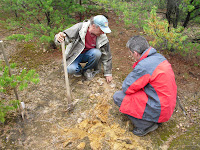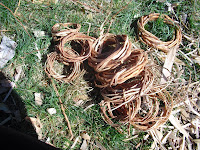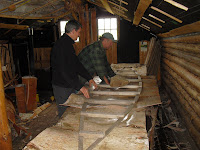 In May 2010 we (Marc van Kempen and Wim van Dijk) travelled, together with our wives, from the Netherlands to Toronto Canada. While the girls started their own road trip we took the Greyhound bus to Sudbury where Tom picked us up and took us to his place on the Vermillion river in Whitefish. There we stayed for 2 weeks to build a Birch bark canoe. The cabin on the right is the place where we lived for 14 days, the shed on the left is the work shed where the canoe will be build. A preview of the canoe we built. The basic model is St.Francis Abenaki but we adjusted the measurements a little. We kept the ends a bit low because we will use it mostly on Scandinavian lakes (but also French rivers!) and this way the canoe will not be blown away. Tom, sitting in the back, and Wim are the first ones paddling the canoe on The Vermillion river after it is finished.
In May 2010 we (Marc van Kempen and Wim van Dijk) travelled, together with our wives, from the Netherlands to Toronto Canada. While the girls started their own road trip we took the Greyhound bus to Sudbury where Tom picked us up and took us to his place on the Vermillion river in Whitefish. There we stayed for 2 weeks to build a Birch bark canoe. The cabin on the right is the place where we lived for 14 days, the shed on the left is the work shed where the canoe will be build. A preview of the canoe we built. The basic model is St.Francis Abenaki but we adjusted the measurements a little. We kept the ends a bit low because we will use it mostly on Scandinavian lakes (but also French rivers!) and this way the canoe will not be blown away. Tom, sitting in the back, and Wim are the first ones paddling the canoe on The Vermillion river after it is finished. Most special on this project was the fact that we started empty handed, went into the Ontario woods with Tom, and gathered all the materials we needed. In 14 days we built the birchbark canoe with hand tools only, and natural materials. Working together with Tom Byers, who taught us his skills, was quite an experience and very instructive. To learn more about Tom visit naturalbirchbarkcanoes.com.
Read our story below, you can click on the pictures to see them in a larger size.























































